Current goings
on in the Fells
2019
There is suddenly a lot of interest in
the invasive plants in the
Fells. Yes, it's serious, and we have 25 invasive species in our woods.
But the big question is how to deal with them. I have put
together a powerpoint presentation with photographs of what they look
like and where in the Fells they are. I also have copies of the
state published booklet describing all invasives statewide.
The
first week of the year was relatively mild with no snow in the
area to talk of. As a result I photographed evergreen plants of the
forest floor such as Striped Wintergreen and its close cousin
Pipsissewa. And on a hill top Bearberry in flowerbud.
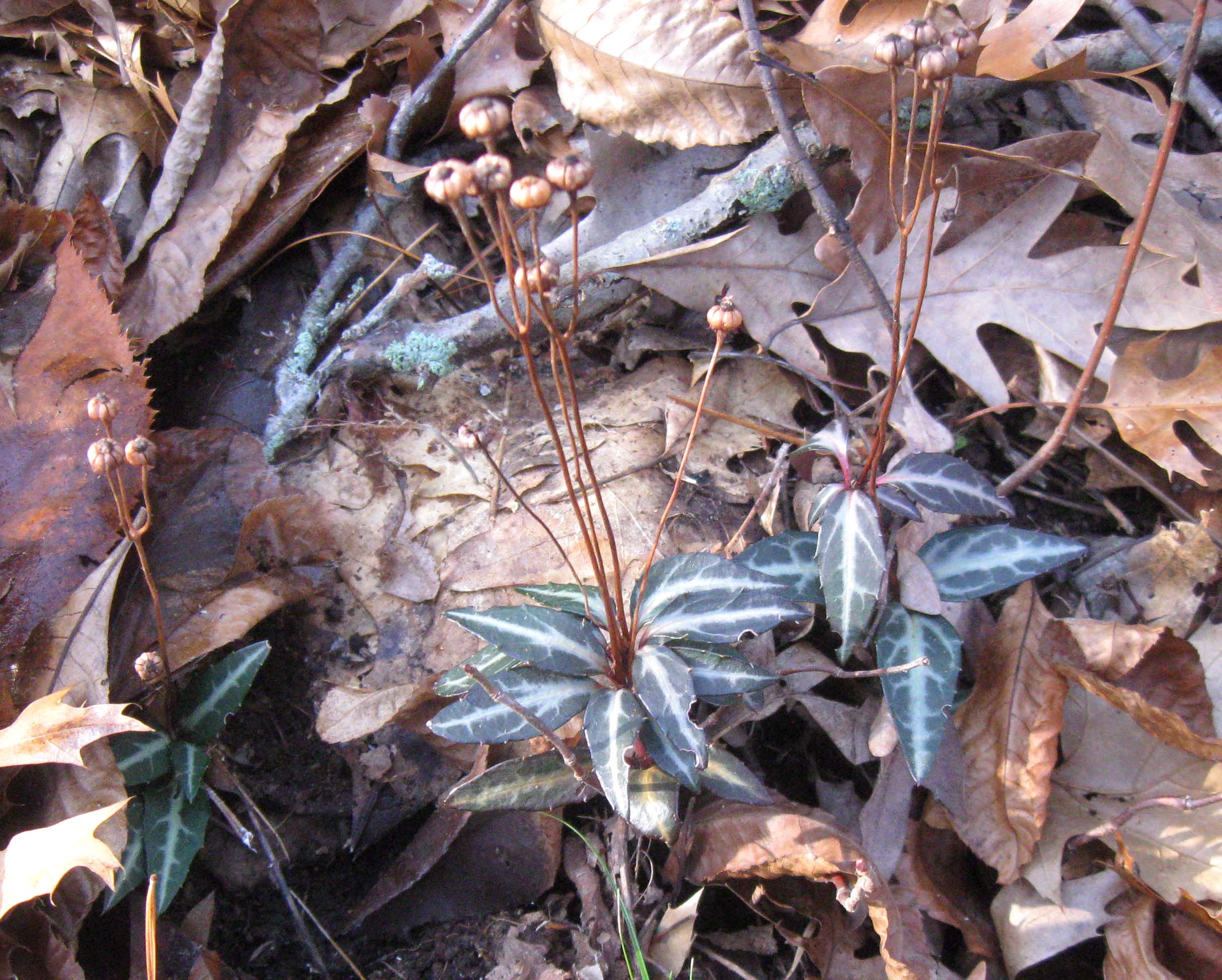
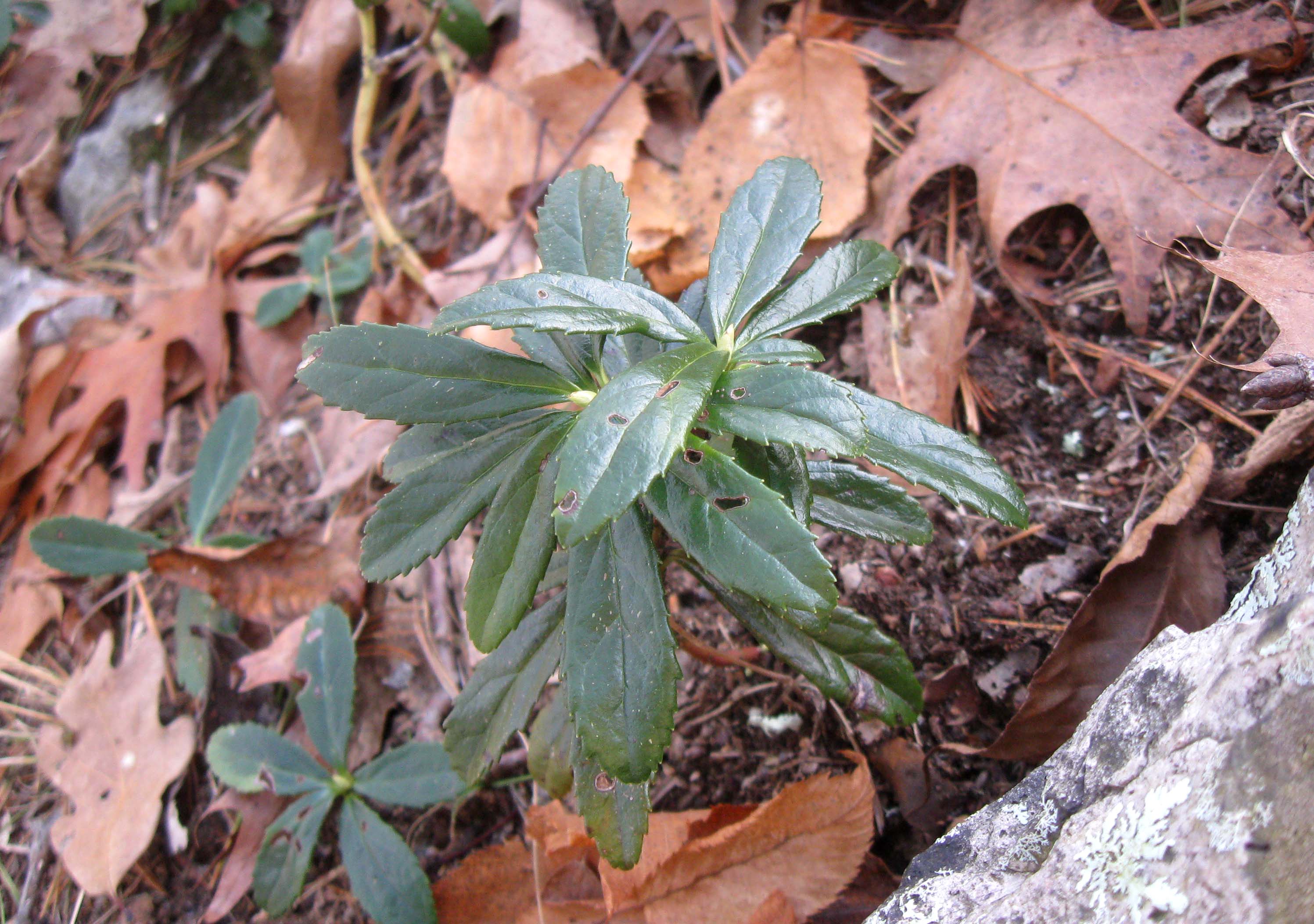
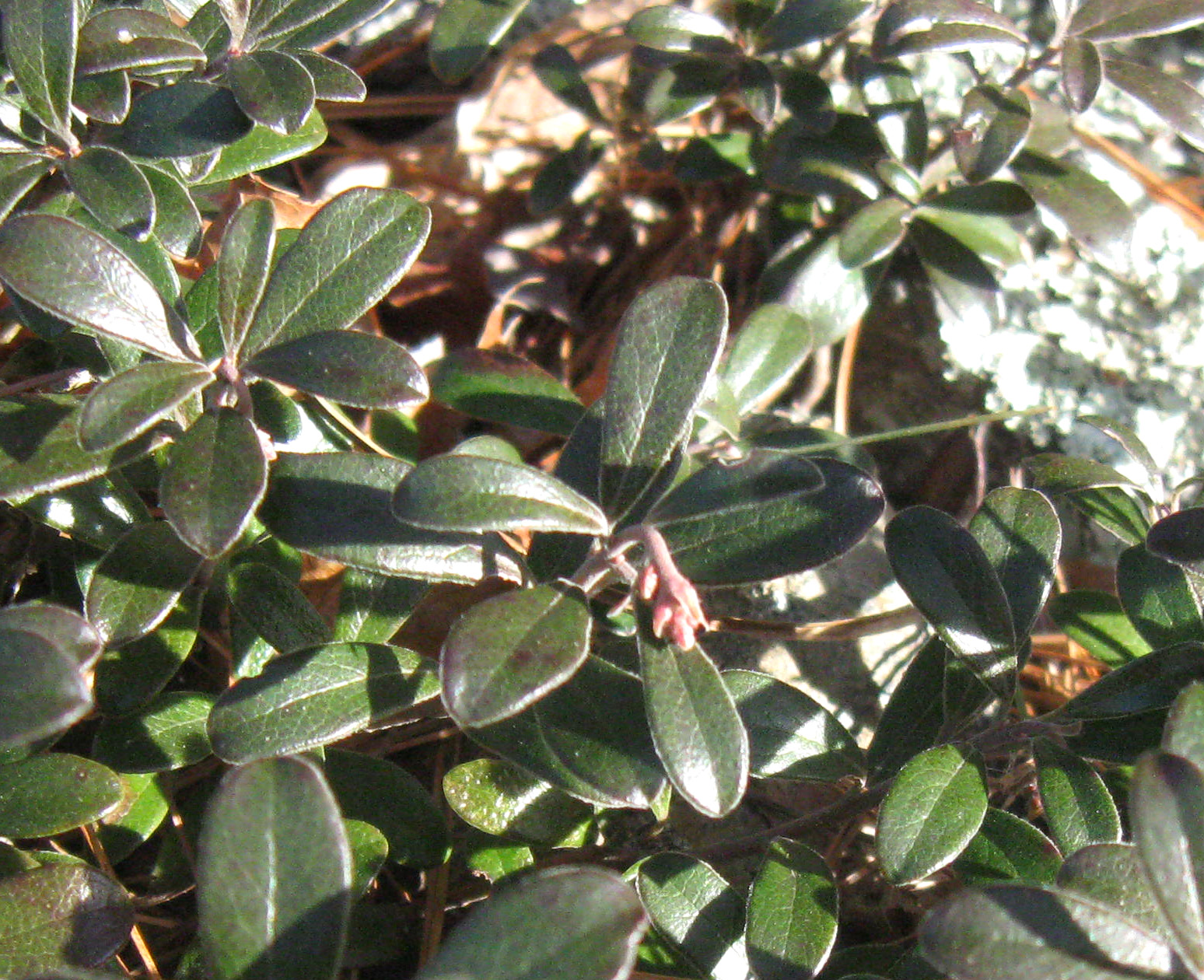
Striped
Wintergreen
Pipsissewa
Bearberry showing a flower bud
Finally, on January 20th, after a record
winter period without snow, the Fells got a covering of a few
inches.
Those forest floor wintergreen plants shown below and photographed this
winter will be fine. They're built for it.
Then as January moved into February we saw
deep cold. The Cascade in the eastern Fells is well worth a visit
at this time.
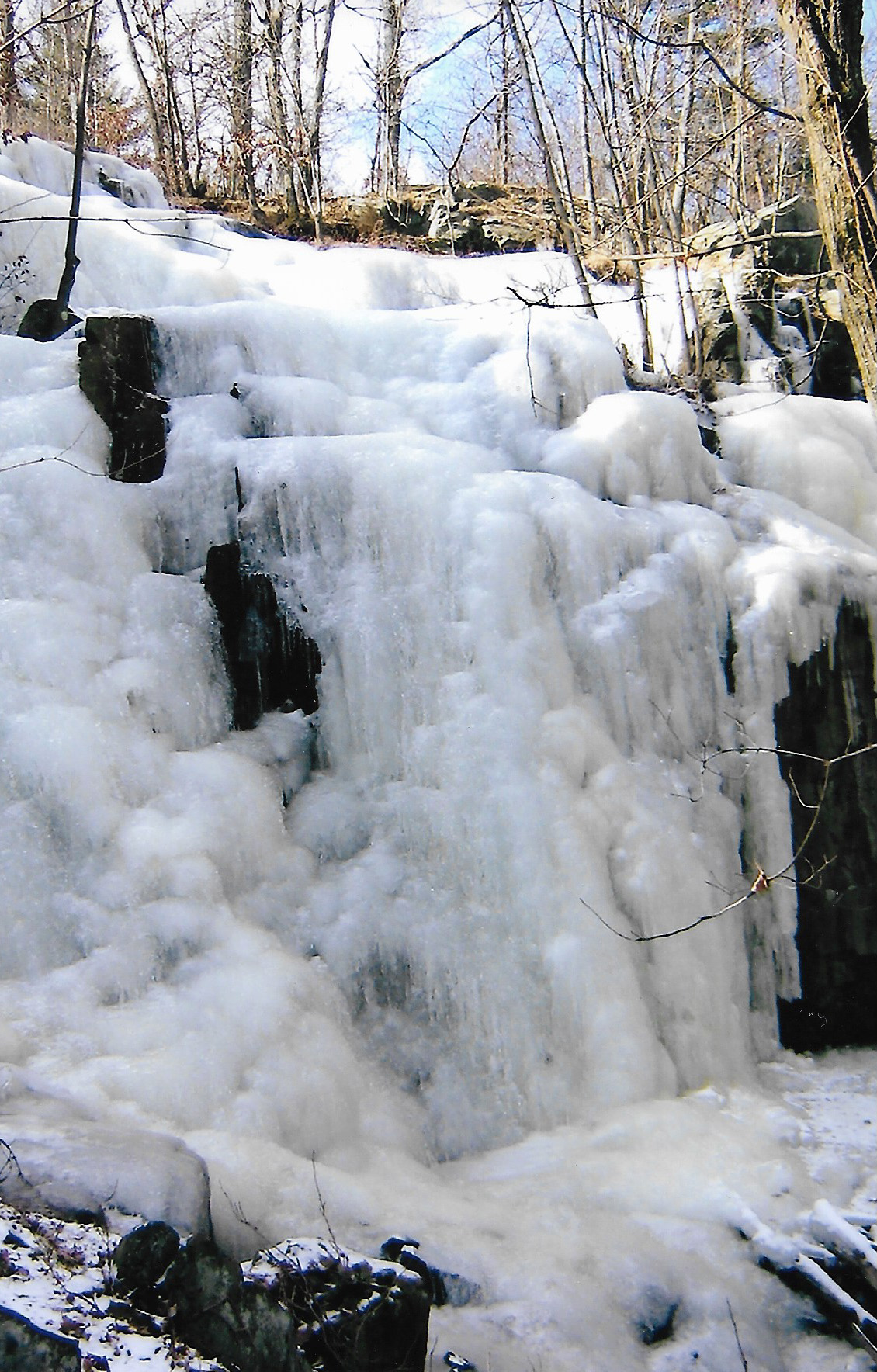
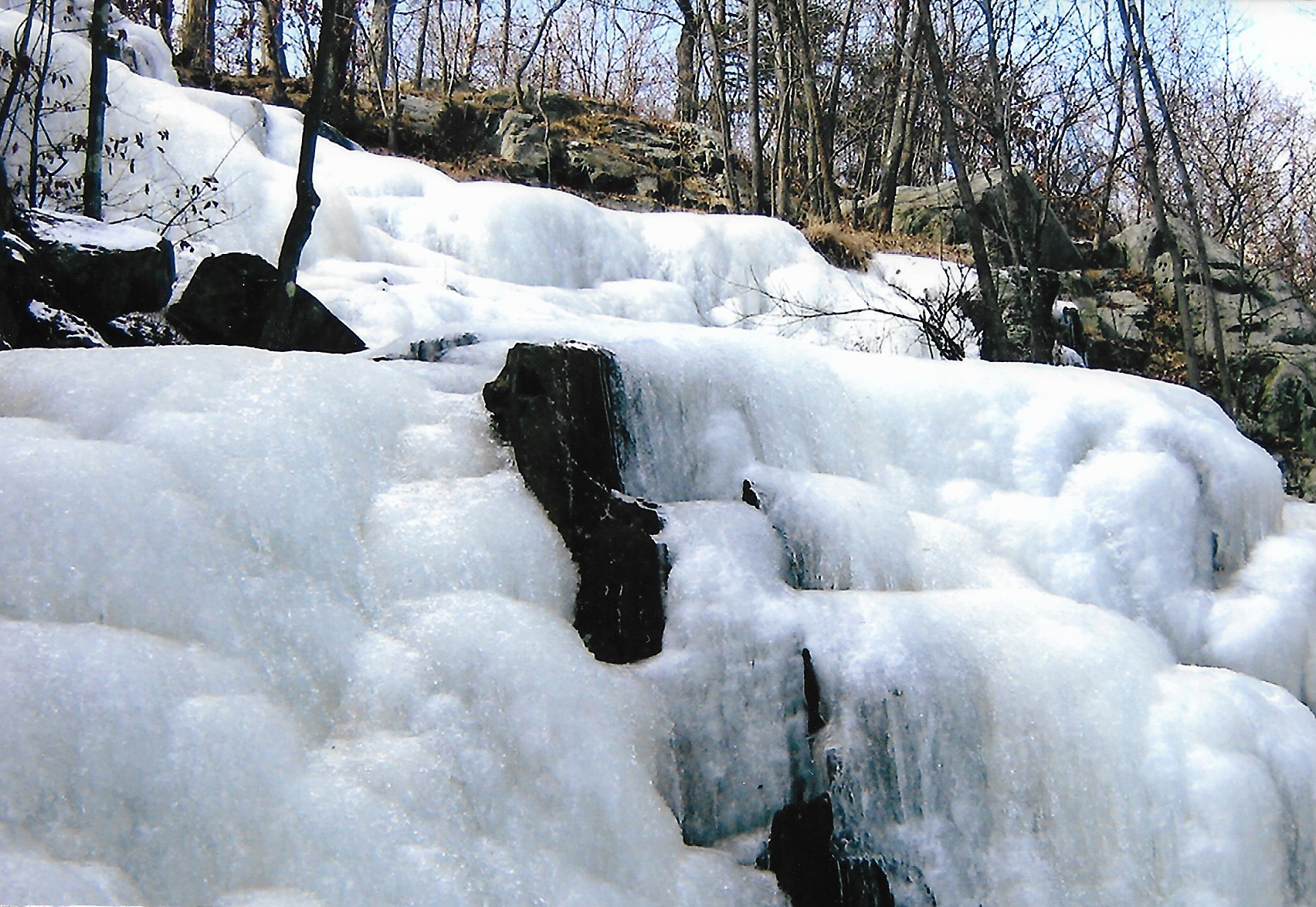
February 2nd marked the 125th anniversary
of the creation of the Middlesex Fells.
A word to Trail Adopters: when Spring comes I'd love
to walk your trail/zone with you, not just to ID invasive plants but to
also point out beautiful native plants, and other interesting things.
2018
Wonderful
news,
Just before Christmas DCR informed Mayor Burke of Medford and the
Friends of the Fells that the proposal to build an ice skating rink at
the 90mm site in Lawrence Woods was NOT going forward. Huge
relief and a wonderful Xmas present. Meanwhile girl scouts and
others of us have been enhancing the site by removing invasive plants
and generally smartening it up. .
More good news.
Thanks to Dennis Crouse, Lindsay Yarsley and Laura Costello an orchid -
Goodyera pubescens - with the
not-so-nice common name of Rattlesnake Plantain - was found in
sector 2 of the Fells. It had been rumored for some time but had
not been officially recorded in recent years till now, Great
news. Thanks friends.
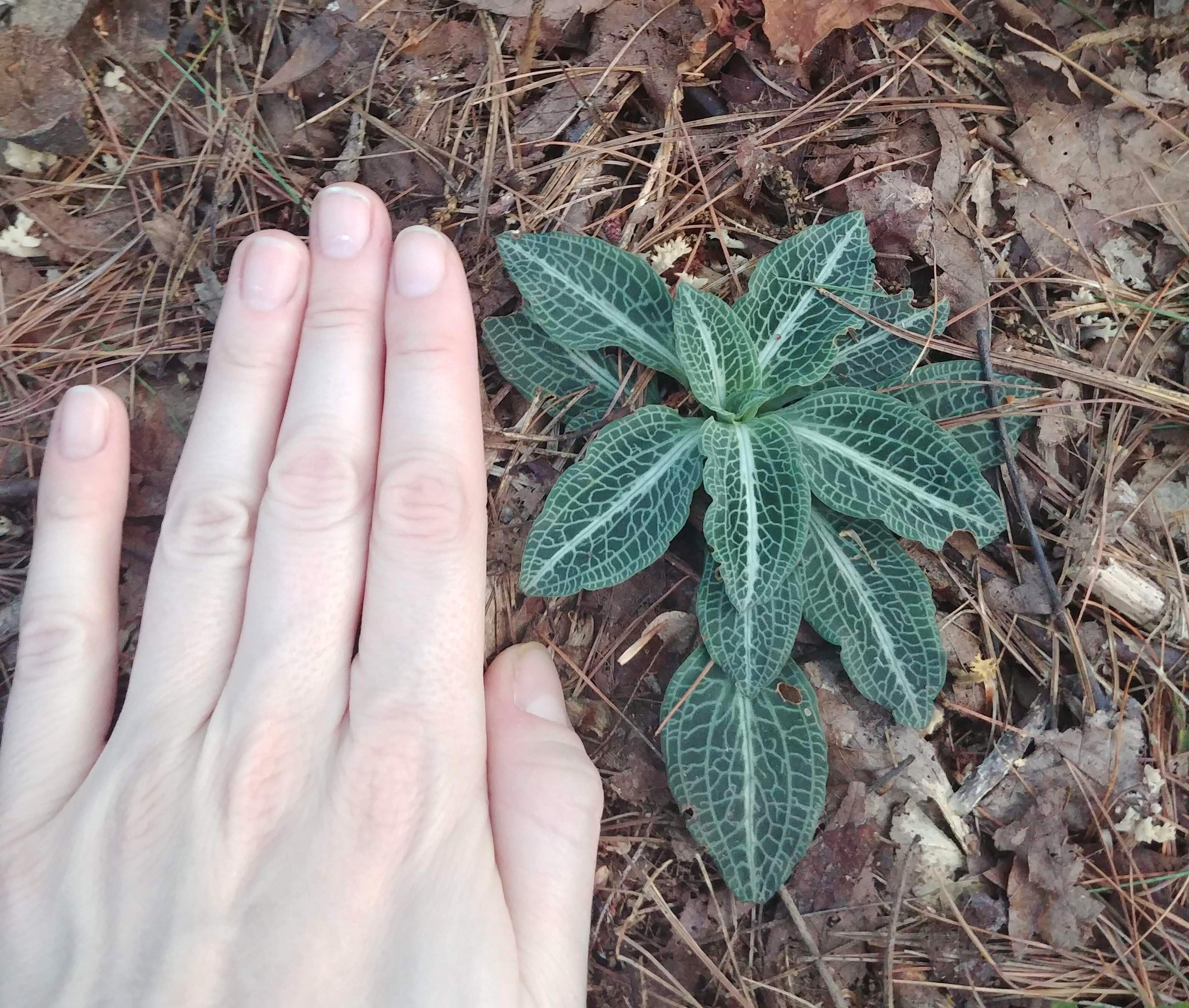
Photo by Laura Costello
December was so
mild
native Witch Hazel - Hamamelis virginiana was seen on
several occasions still in bloom , not that the flower is that pretty
:-)
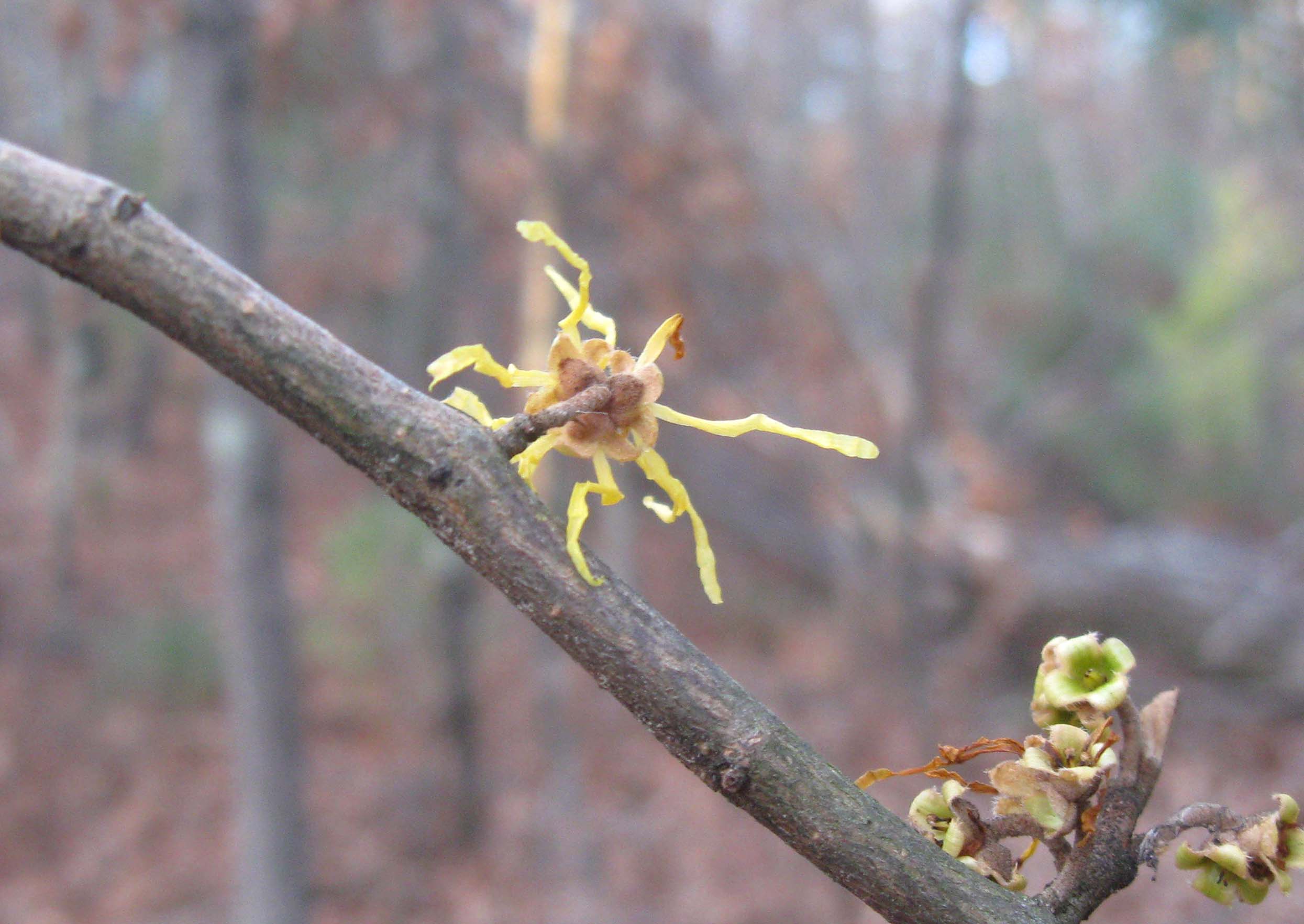
2017
February was unusually mild and I saw Skunk Cabbage open on Feb 25th,
beating last year's record of the 28th. Just one little hint of climate
change.
A Note in the journal Rhodora by
Walter Kittredge and myself appeared in March entitled "Continuing
discoveries in the Middlesex Fells." Rhodora Vol. 118, No.
976. This is the third follow-up Note to our main paper in Rhodora about the plants of the
Fells which was published in 2012.
Neverthless our findings continue. Walter found a sedge Carex cumulata last reported
in the Fells in the 1920s; and
identified another sedge that I had found earlier as Carex tenera, last reported in
1896.
So, there's still stuff to find in the Fells.
In fact my own focus has been to be sure that the abundance reporting
of species is as accurate as possible. A decline, particularly if it's
of a native species is concerning and also not easy to be sure about.
Nevertheless I have seen a marked decline in Canada Lilies and Nodding
Trilliums in the past few years which I'm pretty sure is due to deer
grazing.
On the positive side, a 'sector find' is when we find a species in one
of the eight sectors of the Fells, not previously reported in that
sector. In 2017 we made 26
sector finds, 14 native species which is good news, and 12 non-native
which is not such good news. This work is being done with the help of
Laura Costello, and as usual Walter Kittredge helping identify things.
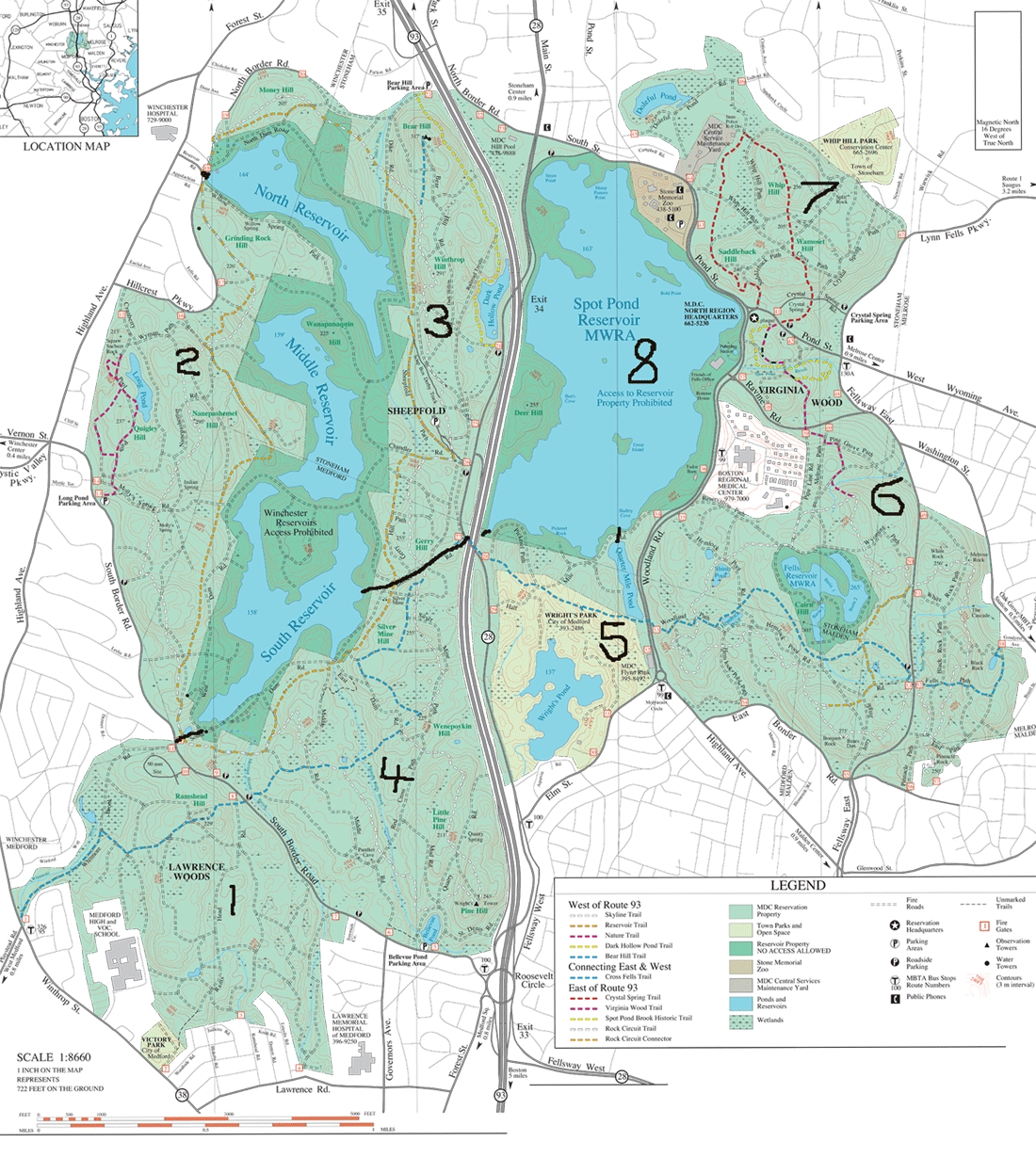
Map of the Fells showing the 8 different sectors
If we find a
species in just one or two sectors we call it 'rare'; if in 3 or 4 -
'occasional'; 5 or 6 - 'frequent'; and if in 7 or all 8 sectors then it
is deemed 'common'.
2016
With record
warmth in February, the Skunk Cabbage opened in the same location in
the Fells a whole month earlier than in 2015. Here is a photo taken on
February
28th. this year. 2015 was the hottest year on record. Then 2016 beat
the 2015 record. Climate change is for real !
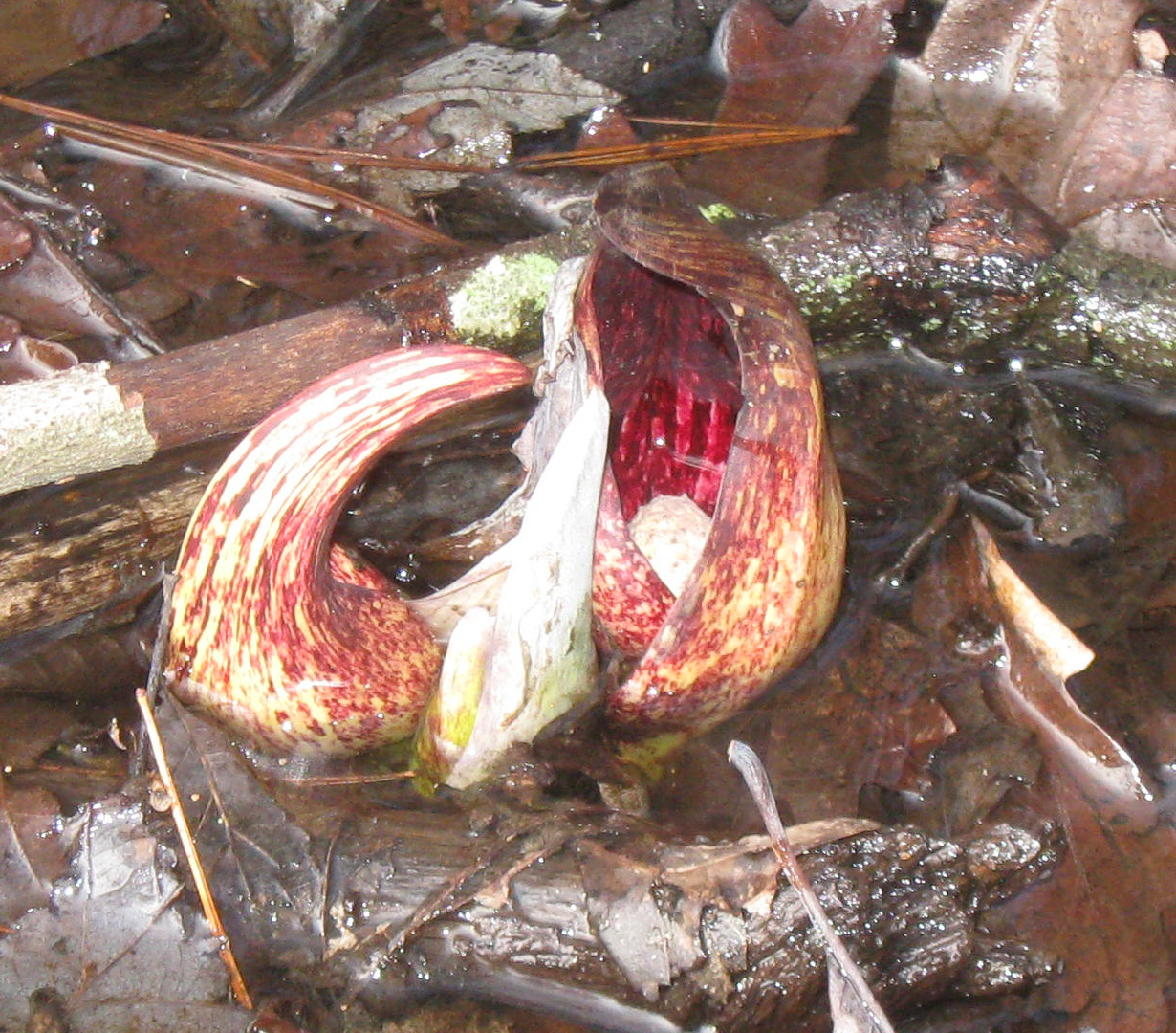
Skunk Cabbage in the Fells, Feb 28, 2016
However, the first
week of May was unusually cold. This
delayed the blooming of Pink Lady Slipper orchids into late May and
early June. After that it was a very hot and dry summer with reservoirs
and ponds in the Fells shrinking considerably.
In early August I came across a patch of Heliopsis helianthoides var. scabra; and in the Fall Walter
Kittredge found one bush of an unusual Crabapple Malus sargentii. Sadly both these
taxa are non-native.
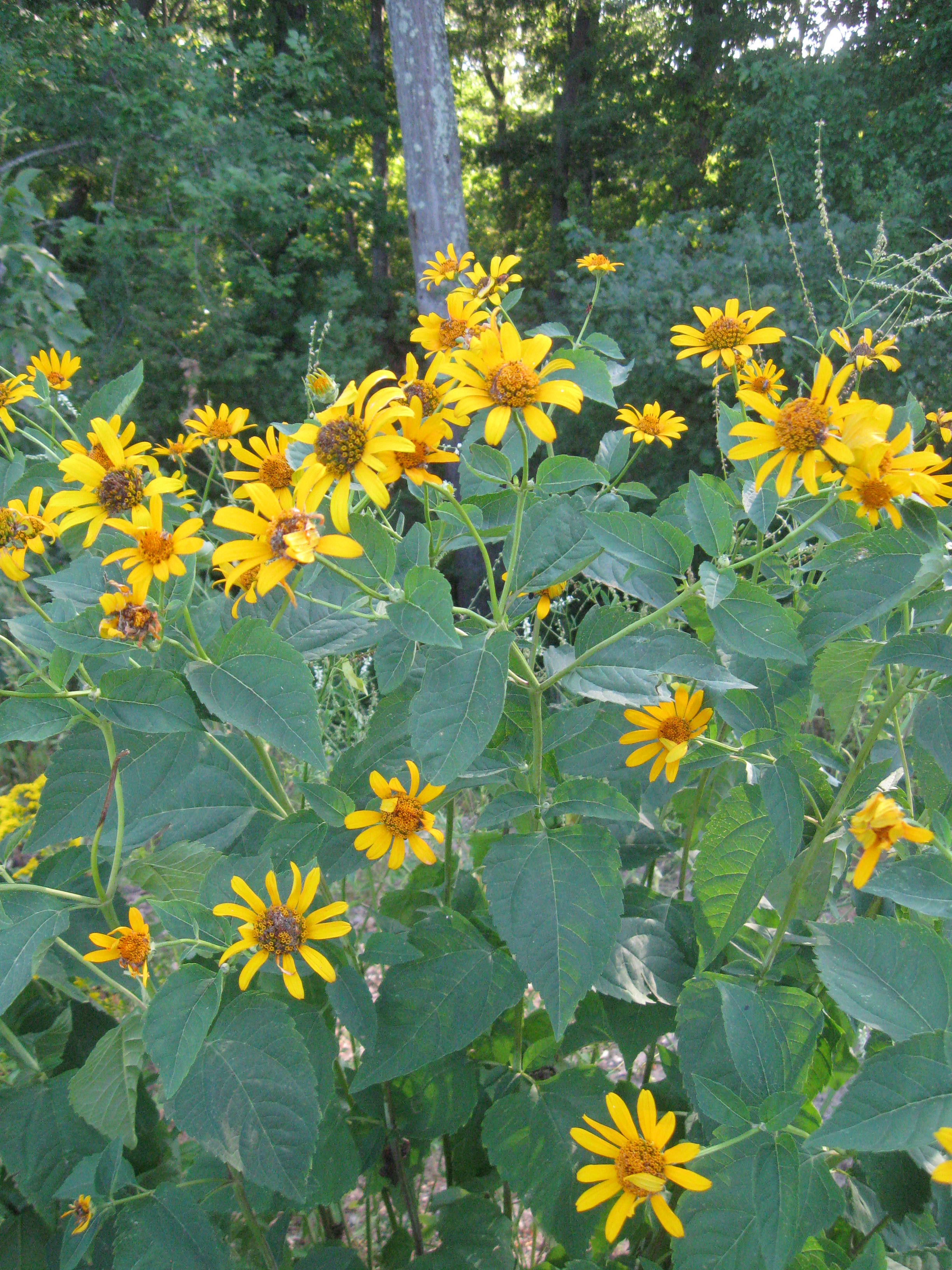
Heliopsis helianthoides var. scabra
Meanwhile, I have found
a few of what we term 'sector finds' - see map further down this page
showing
the Fells divied into 8 sectors. This means an increase in frequency -
a rough measure of abundance in the reservation. Seven are natives -
good news; six
non-natives - not so good news.
As the year closed out I received exciting
information from friends
Irina Kadis and Alexey Zinoviev that during 2016 they had made some
important finds in the Fells.: Wild Coffee - Triosteum aurantiacum,
Small-flowered Buttercup - Ranunculus
micranthus both native plants not reported since
1896; and Japanese Stiltgrass - Microstegium vimineum an
invasive grass, so not such a nice find, but still important to note
it.; plus a couple of other probables to be confirmed - a great
piece of work. Thank you Irina and Alexey.
Findings in 2015 (for earlier
findings since the 2012 publication see further down this
page.)
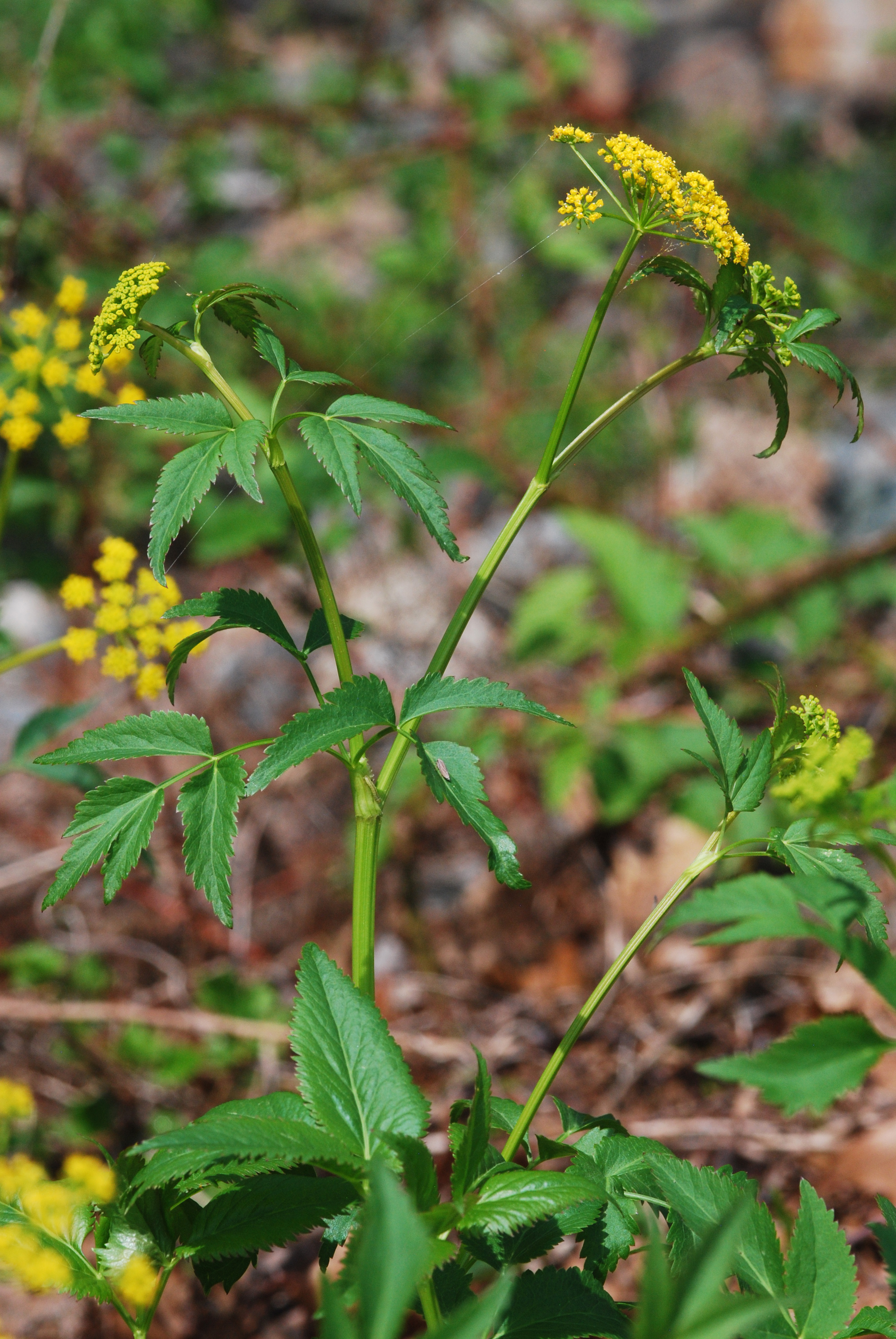
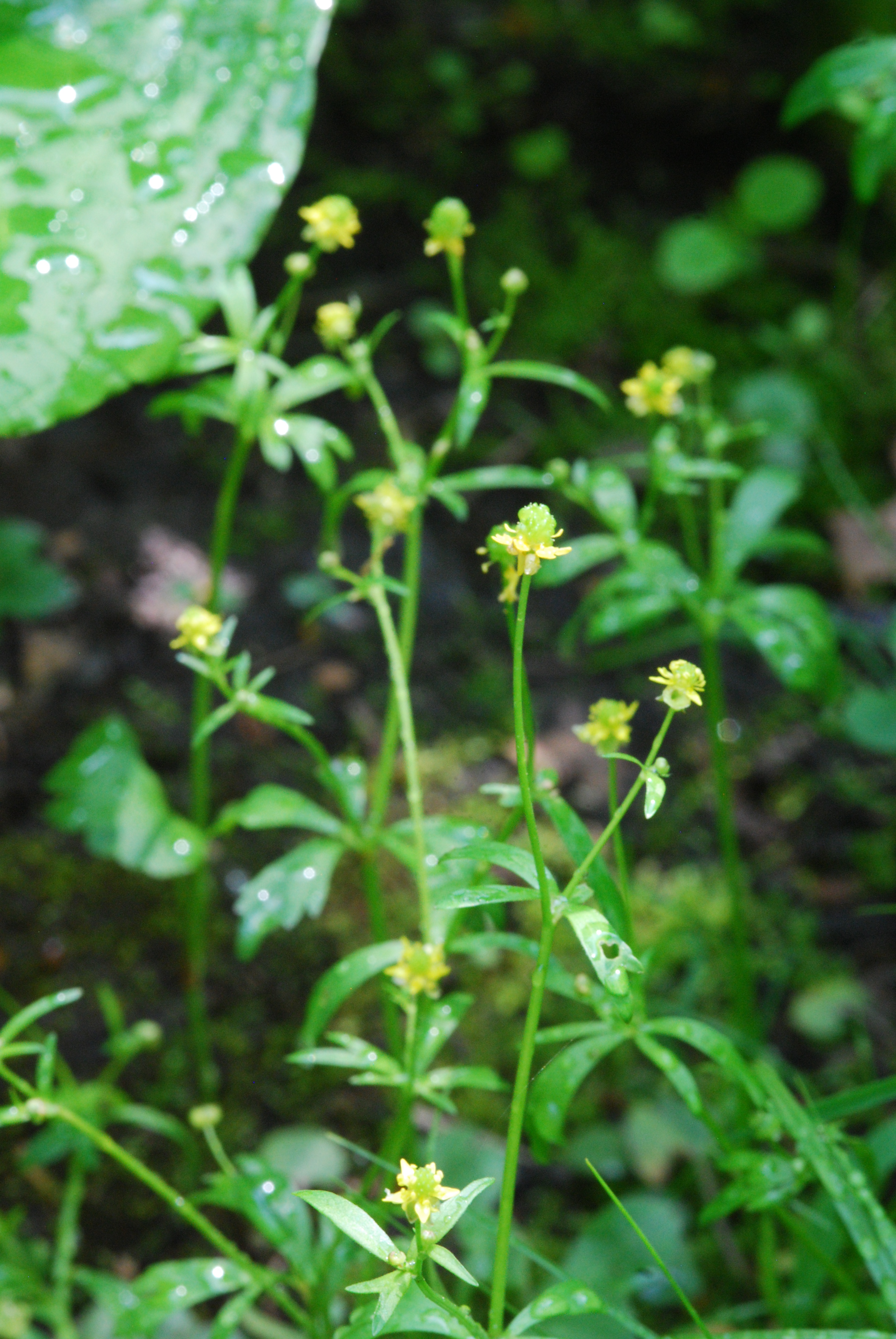
Golden Alexanders - Zizia
aurea
A small-flowered Buttercup - Ranunculus
abortivus
2015 was a good year for new finds in the Fells. Walter
Kittredge and I found ten species never before reported in the Fells.
What was most exciting was that eight out of the ten are native
species. Because it was an exceptionally (perhaps troubling so) dry
year this allowed easier access to various wetland areas which is where
several of these new species were found.
Adoxaceae
|
Viburnum opulus subsp. trilobum
|
N
|
Apiaceae
|
Zizia aurea
|
N
|
Ceratophyllaceae
|
Ceratophyllum demersum
|
N
|
Cyperaceae
|
Scirpus atrocinctus
|
N
|
Cyperaceae
|
Scirpus pedicellatus
|
N
|
Fabaceae
|
Colutea arborescens
|
I
|
Gentianaceae
|
Bartonia paniculata
|
N
|
Potamogetonaceae
|
Potamogeton berchtoldii
|
N
|
Potamogetonaceae
|
Potamogeton gemniparus
|
N
|
Rosaceae
|
Malus prunifolia
|
I
|
Golden Alexanders is a common roadside native plant, common
particularly in western Mass., but never reported in the Fells before.
Here would seem to be a case of a recent native arrival, as it is
difficult to believe that such a showy plant would go unseen for 121
years. In addition, a problem that has bothered me for a while was
resolved. There are basically two species of small-flowered
buttercup. One is supposed to be common, the other is considered rare
enough to be state-listed in Mass. In recent years we have only been
able to find (by the hundred) the rare species Ranunculus allegheniensis distinguished
by pronounced hooks on top of its fruit. Although reported before in
the Fells, I had personally never found the more common species
- Ranunculus abortivus, with
straight spikes on top the fruit. Finally, I found a patch in May of
2015. Clearly I had not sampled enough :-). In addition we found five
taxa ( two native, three non-native) not reported in the Fells since
earlier surveys in the 1890s or 1920s. Allowing for 7 species
which we believe have taken their leave of the Fells in the last few
years, our current
total for the reservation is 918 (586 or 64% of which
are
considered native).
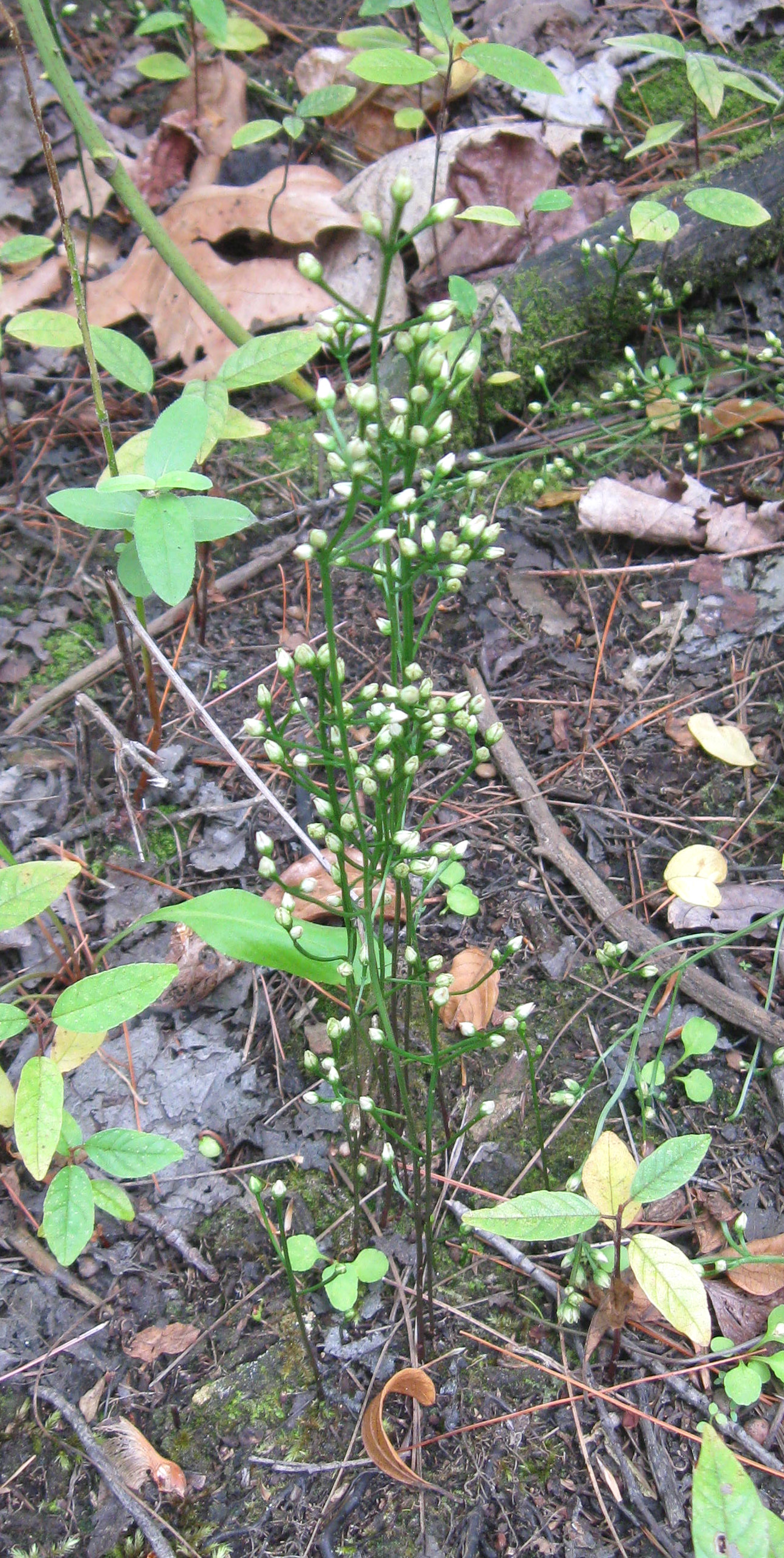

Bartonia
paniculata an
unusual
close-up of fruit of Ranunculus
abortivus
saprophyte found on the muddy shore
of one of the reservoirs.
Findings in 2014.
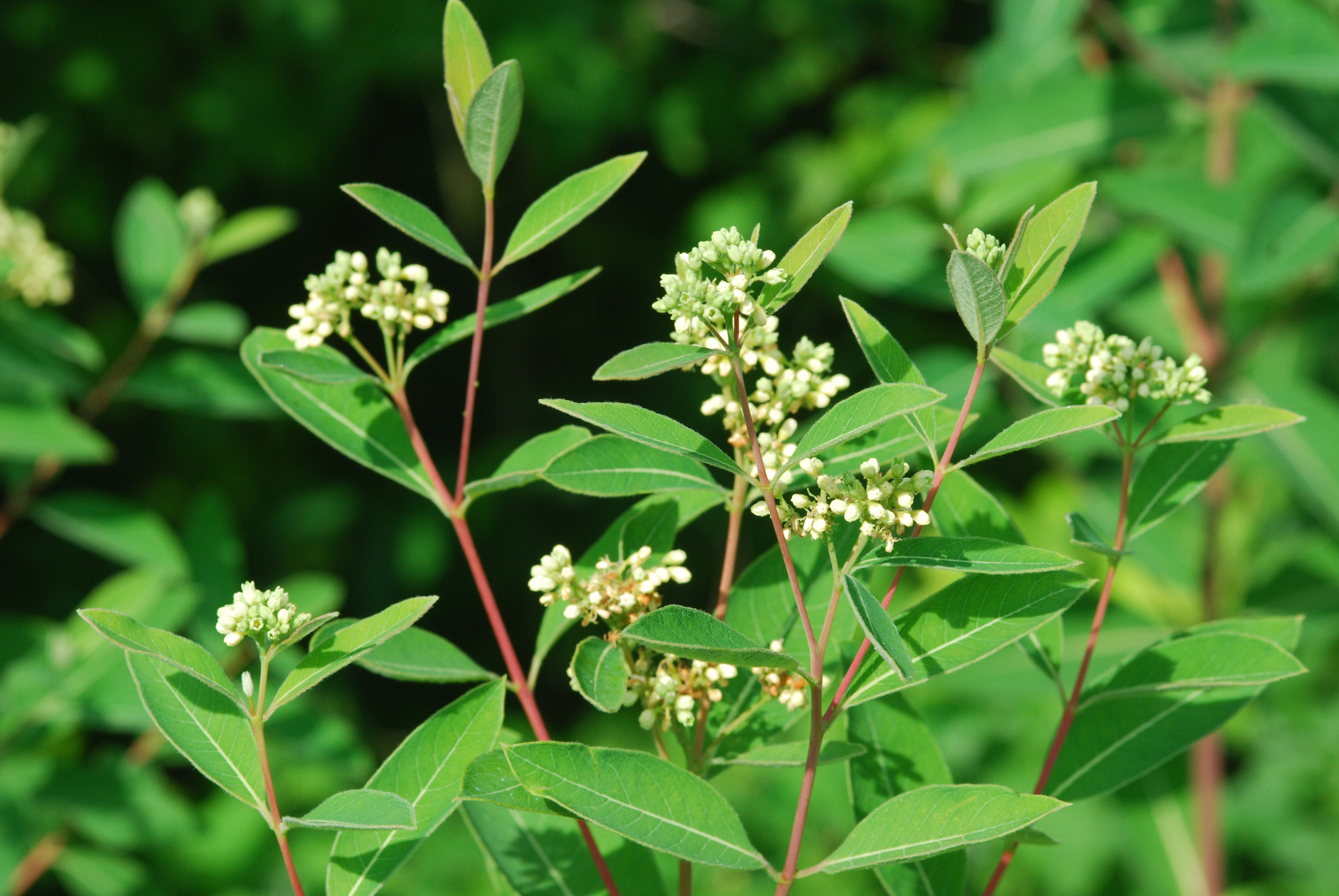
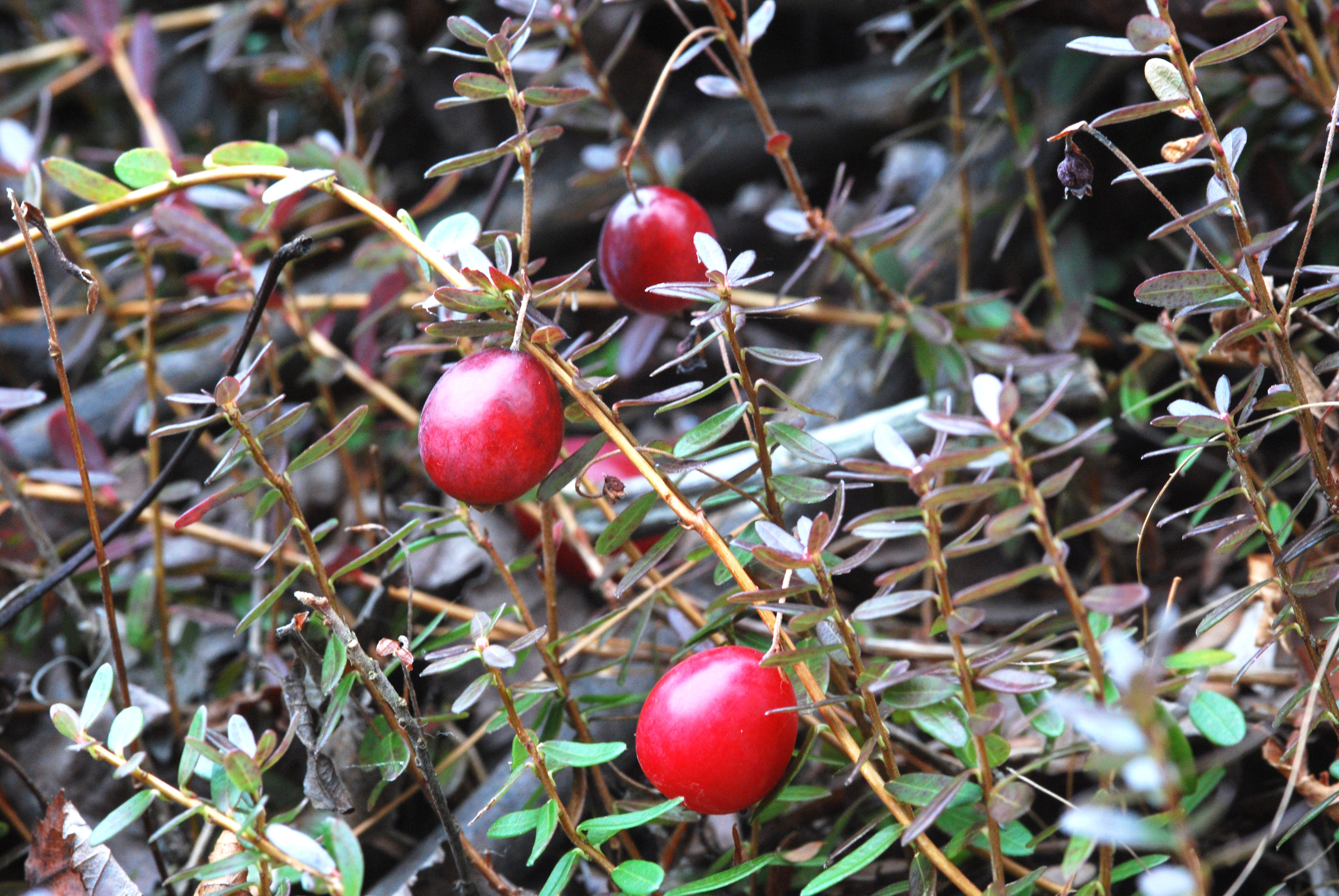
Prairie Dogbane - Apocynum
cannabinum
Cranberry - Vaccinium
macrocarpon
These native plants, reported in the Fells by Deane in
1896,
were re-found in 2014; the Prairie Dogbane by Walter Kittredge in
June; the Cranberry by Bryan Hamlin in December. A non-native
Hawthorn species - Crateagus
crus-galli, also new to the Fells, was jointly discovered by
Hamlin and Kittredge in July, 2014.
Further discoveries in 2013
In 2013 we had a
further 11 new finds, four of which were native. These findings
resulted in a further small
paper in Rhodora, published in 2014.
In February 2013, Arnoldia, the magazine of Harvard
University's Arnold Arboretum, published a beautifully illustrated
article by Walter Kittredge entitled The
Middlesex fells, a Flourishing Urban Forest (Vol. 70, N0.
3). This ten-page article describes the floristic history of the
Fells in a more readable form than the scientific article in Rhodora in 2012.
http://arnoldia.arboretum.harvard.edu/pdf/articles/2013-70-3-the-middlesex-fells-a-flourishing-urban-forestno-title.pdf
2012
season
In the 2012 season we found 19
additional plant species not included in
the main published survey (Hamlin et al. 2012). This was reported in a
New England Note in the Spring 2013 issue of Rhodora. Fourteen were
non-native some
of which therefore probably represent new arrivals; but five
of the new finds were native
species. In the spring of 2012 we were
excited to
stumble upon a small patch of the three-lobed violet – Viola
palmata. It was reported in 1854 in an area that later became part
of the Fells. It is possible that these native species have been
in the Fells all the while
and have been overlooked.
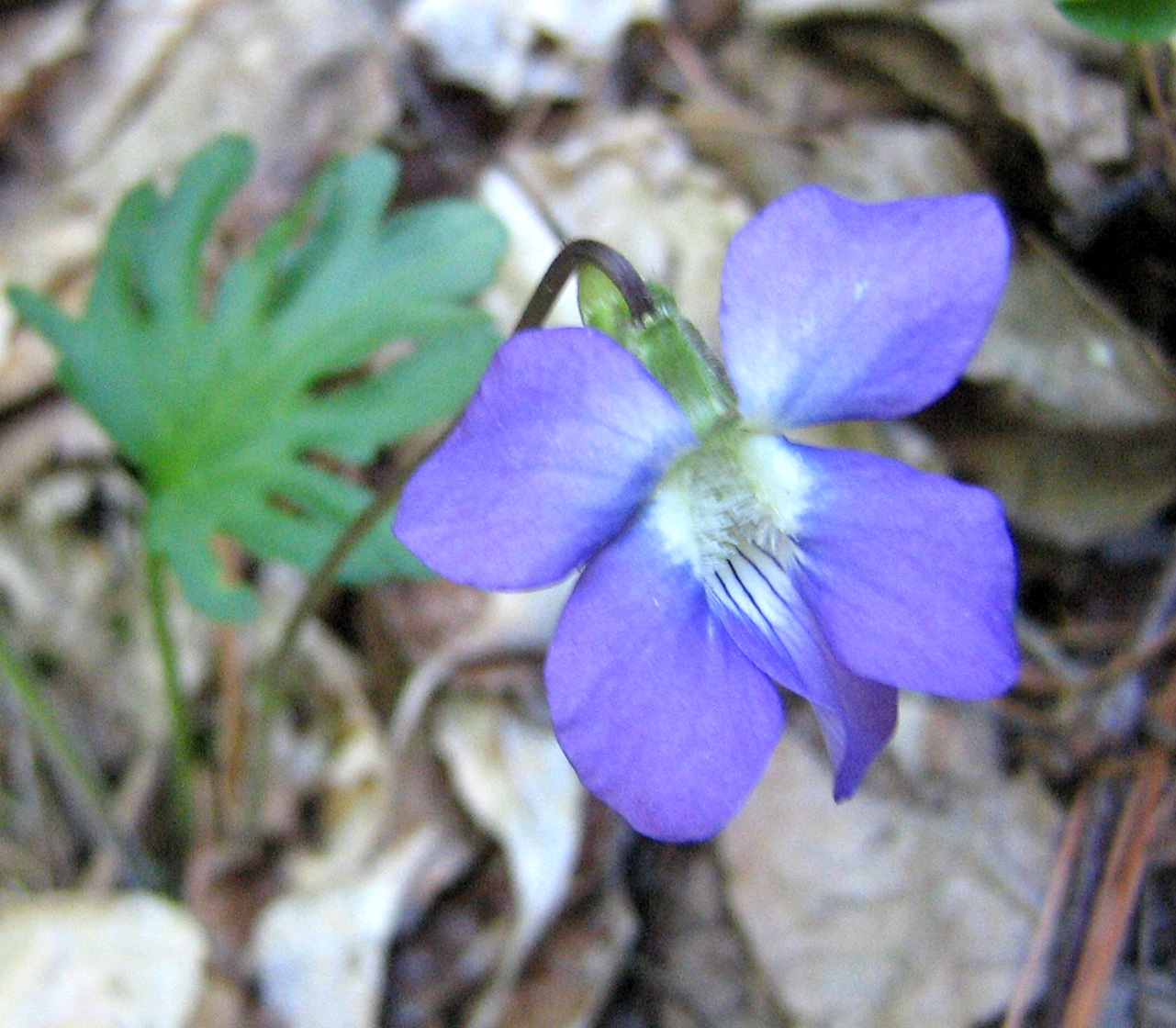
Viola palmata File photo by
Hamlin
As a
result of
these new findings in 2012 a five-page Update note was published in
Rhodora in June 2013 covering these new findings in 2012. Hamlin,
B. T. & W. T. Kittredge. 2013. An update on the Middlesex fells
Flora. Rhodora, Vol. 115: 191-196.
Sector finds
For the purposes of determining a frequency of occurrence for each
species,
the Fells was subdivided into eight sectors of approximately equal size
using roads and bodies of water as boundaries as shown on this map.
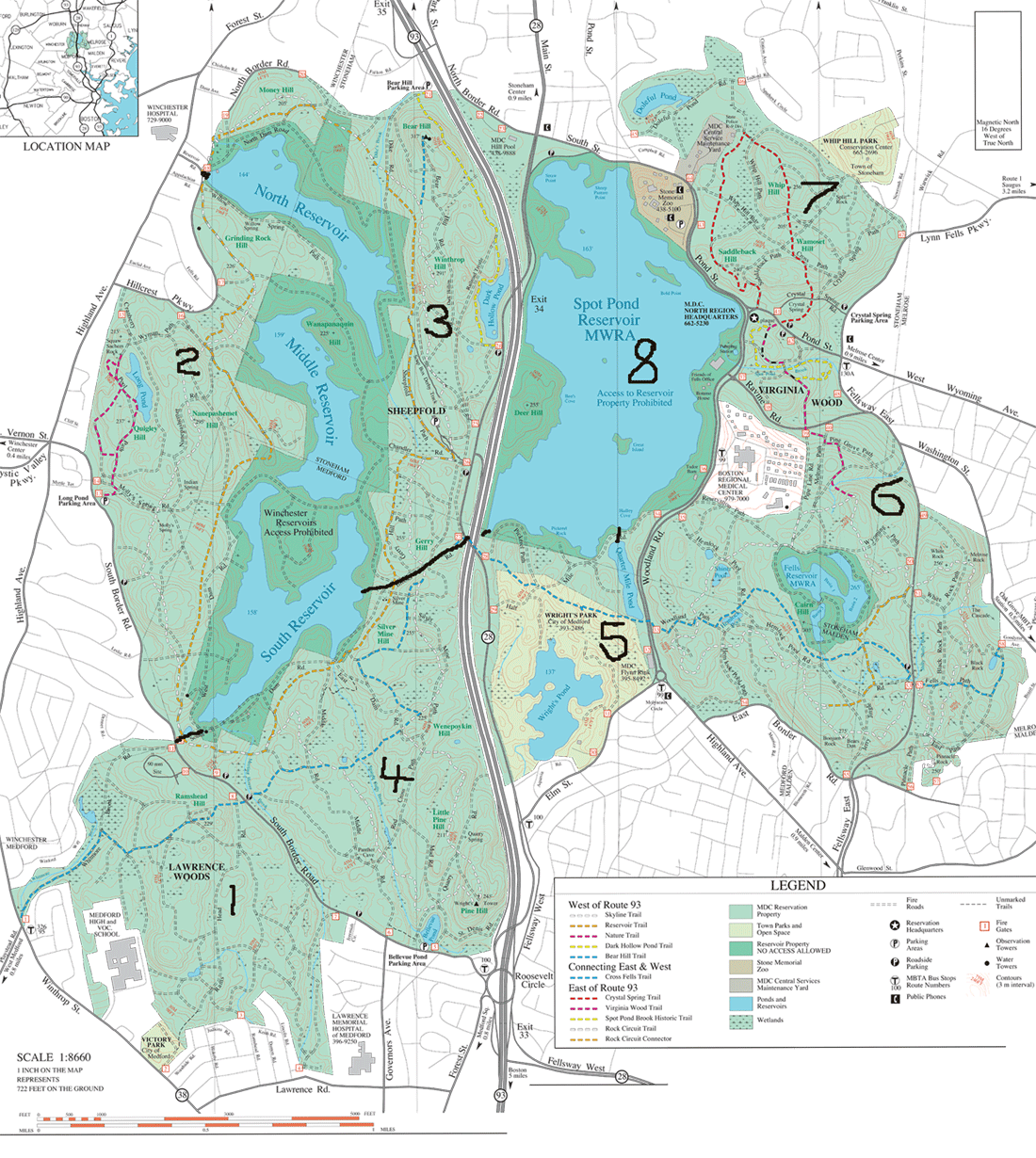
The
basic map image is reproduced with
permission of the Friends of the Fells and the Department of
Conservation and Recreation. To zoom in:
right click, choose 'view image', and click again.
If a
species was found in only one or two sectors it was deemed Rare, if in
three or four then Occasional, five or six - Frequent, and if in seven
or all eight sectors then we called it Common.
A History of plant surveys of the Fells
Upon
creation of the
Middlesex Fells as a
reservation in 1894 a floral survey was conducted by Walter Deane and
Warren Manning and others, and published in 1896.
We owe a great debt
to these pioneers for
providing us with this base-line of what plant species existed in the
Fells over a century ago. Here is the map of the Fells that accompanied
Deane's Flora.
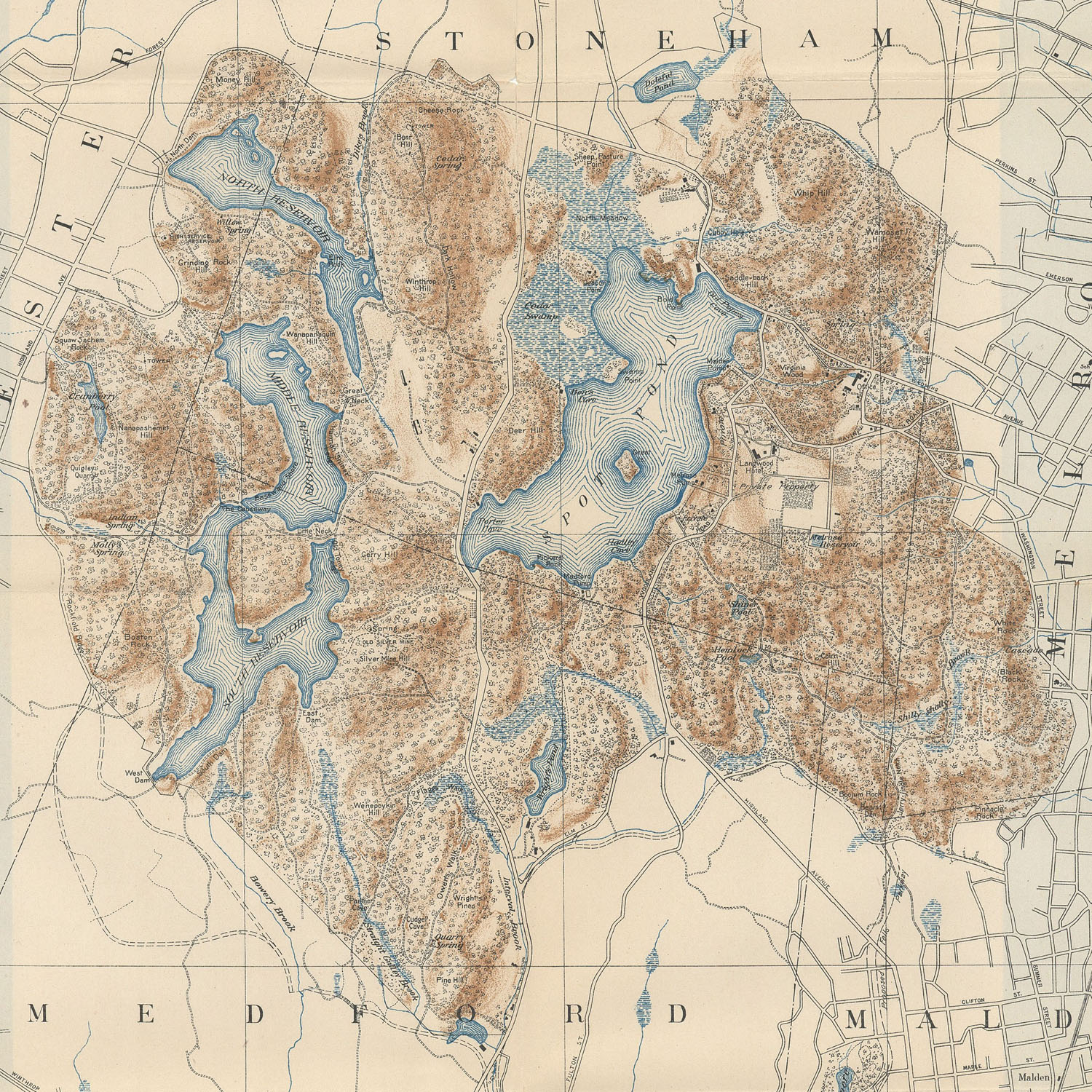
reproduced
by permission from the archives of the Gray Herbarium, Harvard
University
Much
has happened to
the Fells since then. New, wider roads
have
been created carrying a lot of traffic, in particular I-93 forming an
almost
solid barrier between an east and west Fells. An electric railway line
has come
and gone (1946), and the soap-box derby track at Sheepfold is still in
evidence. Although land has been lost to the road widenings, the
creation of Stoneham Zoo and, to some extent, Wright's Park, there have
been a few gains as well, most significantly
the addition of Lawrence Woods in the southwest. General Samuel C.
Lawrence, the first mayor of the City of Medford, owned a huge estate
part of which was wooded. The public were welcome into these woods so
that they served as an unofficial annexe to the Fells in the early
years. General Lawrence
died in 1911 and in 1925 this wooded part, now known as Lawrence Woods,
was officially added to the Fells.
For more details on the first forty
years of the Fells I recommend Round
About the Middlesex Fells published
by the Medford Historical
Society in 1935. Compared with the original condition, where there were
more fields and open spaces, the
Fells has been allowed to go back to a reasonably
natural
state with re-growth of forest as well as much tree planting in
the
early part of the 20th century. But in the first decade or so of the
20th
century the trees of the Fells were hit very badly with gypsy moth
infestations. Human usage is on the
increase
and invasive species have made their encroachments. All these things
have
brought, and
will continue to bring, changes to the flora of the Fells. Between 1920
-1922, Nathaniel Kidder collected many plant samples in the Fells which
are
now held at the Harvard Herbarium. He did not publish a report.
As the centenary of
the reservation
approached, a survey of flowering plants was made by Brian
Drayton
through three growing seasons between 1990 and 1992 (Drayton and
Primack, 1996).
Drayton compares what he
found to
what Deane had found a century earlier, noting in what location he
found particular plants. Most interesting are the lists of those plants
found
by Deane but not found by Drayton, and vice versa. Sadly, but not
too
surprisingly, the former is the longer list. It should be noted however that Drayton confined his area of
survey to west of I-93 and north of South Border Road, therefore
only about 40% of the present total. Not all subsequent reporting on
Drayton's
work has taken sufficient note of this. Because of a difference in the
underlying geology between West and East Fells, there are quite a few
species only found, and still found, in the eastern part. This meant
that there had been no published
survey east of I-93 since the original Deane survey, and never any
published survey of Lawrence Woods, shown as sector 1 on the Fells
map above.
A
full plant survey of all the Fells was therefore required. I began
making a
simple check-list in 2003. Teamwork was needed in this large task. The
2003 - 2011 survey ultimately involved several people including Betty
Wright
(trained by
the New England Wildflower Society), Irina Kadis of the Arnold
Arboretum, and Don Lubin, one of the leading authorities on ferns in
New England. Starting in 2007, and particularly since 2008,
much work has been done by Walter Kittredge of the Harvard Herbaria,
taking things to a new level, including the documenting of thirty
different habitat types - a major work in itself - and finding many
more
species, especially grasses. Other specialists helped with
certain groups of plants, including Alexey Zinoviev with willows and
Lisa
Standley with sedges. Further acknowledgments are given in the Rhodora
paper.
Deane, W. ed.
1896. Flora of the Blue Hills, Middlesex Fells, Stony Brook and Beaver
Brook
Reservations of the Metropolitan Parks Commission, Massachusetts. C. M. Barrows & Co.
Boston, MA.
Drayton, B. & R. B. Primack.
1996. Plant
species lost in an isolated conservation area in metropolitan Boston from 1894 to 1993.
Conservation Biol. 10, No.
1: 30-39.
Hamlin, B. T., W. T.
Kiitredge, D. P. Lubin and E. B.
Wright. 2012. Changes in the vascular flora of the
Middlesex Fells Reservation, Middlesex County, Massachusetts, from 1895
to 2011. Rhodora, Vol. 114: 229 - 308.







 Photo by Laura Costello
Photo by Laura Costello







